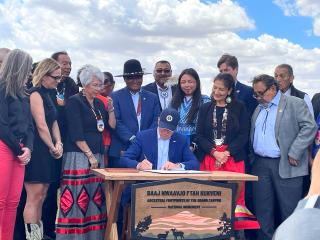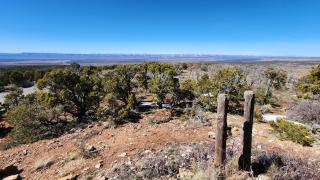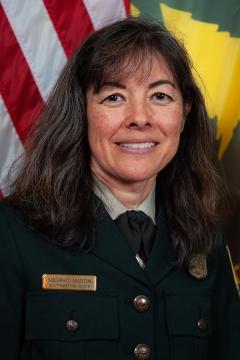Baaj Nwaavjo I’tah Kukveni—Ancestral Footprints of the Grand Canyon National Monument presidential designation

On Tuesday, the Southwestern Region was honored to host President Biden and USDA Deputy Secretary Xochitl Torres Small for the presidential designation of the Baaj Nwaavjo I’tah Kukveni—Ancestral Footprints of the Grand Canyon National Monument in northern Arizona.
The national monument designation (watch the C-SPAN video) builds upon decades of effort from tribal nations, state and local officials, advocates for outdoor recreation and conservation, local business owners and members of Congress. The new national monument consists of three distinct areas to the north and south of Grand Canyon National Park, totaling approximately 917,599 acres of federal lands which will be recognized and preserved in perpetuity.
These lands are at the heart of many tribes in the region, including the Havasupai Tribe, Hopi Tribe, Hualapai Tribe, Kaibab Band of Paiute Indians, Las Vegas Paiute Tribe, Moapa Band of Paiutes, Paiute Indian Tribe of Utah, Navajo Nation, San Juan Southern Paiute Tribe, Yavapai-Apache Nation, Yavapai Prescott, Pueblo of Zuni and the Colorado River Indian Tribes. The Havasupai call the land Baaj Nwaavjo, which means “where Indigenous peoples roam,” and the Hopi call it I’tah Kukveni, which means “our ancestral footprints.”

The monument area is replete with evidence of thousands of years of human habitation, including dwelling sites, pottery and lithic sites containing stone tools. Indigenous peoples continue to practice their traditional lifeways within this area, including religious ceremonies and gathering and utilizing natural resources, including those unique and exclusive to this region.
Though the Grand Canyon and its surrounding wilderness have played a central role in America’s conservation history, there is also a deeply painful aspect of its story for the Indigenous peoples in this region. For many decades, the federal government used the establishment of the Grand Canyon National Park to justify denying tribal members access to their homelands and sacred spaces. In addition, the government permitted and encouraged the intensive exploitation of regional resources to aid in the establishment of the nuclear age.
For decades, the tribal nations and Indigenous peoples of the Grand Canyon region have worked to protect these lands, waters and cultural resources from the effects of this development and to clean up the abandoned mines and related pollution that has been left behind. The establishment of this national monument represents an abiding partnership between the United States and the area’s tribal nations that will ensure that current and future generations can learn from and experience the unique and abundant historic and scientific objects found there. It’s also an important step in the long process of addressing past injustices.
In addition to the area’s crucial role in the histories, livelihoods and religious practices of surrounding tribal nations and Indigenous peoples, there is a wealth of unique, geological systems of great scientific value. The groundwater dynamics of the region are one of the best-studied in the United States due to their unique sedimentary and tectonic history. This unique system has supported Indigenous people and regional wildlife since time immemorial and continues to do so. Sites throughout the monument hold opportunities for study in tectonic uplift, cave and karst formation, and paleontology.
A diverse array of unique plant and animal species inhabit the monument area. The designation provides opportunities for study and preservation of the precious riparian vegetation; sensitive, threatened and endangered species in the region; and other flora and fauna essential to the ecological health of the entire region. Pronghorn, elk, bison and mountain lions can be found on and around the area's plateaus, in addition to mule deer, which travel through the northwestern and northeastern areas as part of an important migratory corridor.

In addition to ensuring the preservation and accessibility of sites and landscapes sacred to neighboring tribal nations and of the scientific and historical resources throughout the monument, the designation supports a wide range of opportunities for outdoor recreation, including hiking, hunting and camping.
The proclamation designating this monument calls for Secretary of the Interior Deb Haaland and USDA Secretary Tom Vilsack to explore opportunities for tribal nations to participate in co-stewardship of the land, as well as establishing a tribal commission, which can consist of one elected officer each from any tribal nation with ancestral ties to the area. In addition, it calls for the secretaries to establish a monument advisory committee including representatives from Arizona Game and Fish Department, state and local governments, tribal nations, recreational users, conservation organizations, the scientific and ranching communities, business owners, the general public in the region, and wildlife, hunting and fishing organizations.
This new monument represents our commitment to growing our connection to the Indigenous peoples and tribal nations in the region to a goal of co-stewardship of the landscapes we share and love. It also represents a vital step toward healing the painful past of exploitation and exclusion for our tribal neighbors. We have planted a seed, and with care and attention, it will grow and flourish, bolstering the vitality of our region, supporting our nation’s prosperity and serving as a touchstone for our connection to the globally connected ecosystems of which it is a part.
Editor's Note: Additional photos from the event are available. Provide feedback about this column, submit questions or suggest topics for future columns through the FS-Employee Feedback inbox.



